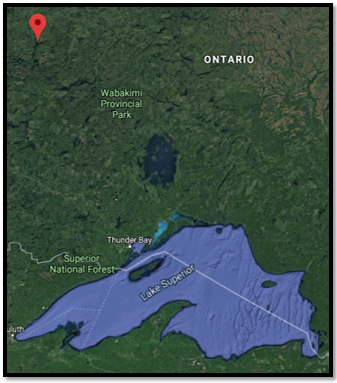Helping the children to heal through artistic expression in the Cat Lake First Nation, Ontario
The Cat Lake First Nation is a remote community made up of nearly 700 people, without year-round road access, in the Kenora district in northern Ontario. In January 2019, the community declared a state of emergency due to a public health crisis, after black mould was found in almost 70 per cent of their homes.
The entire First Nation has since been struggling with the effects of the poor housing conditions, which include skin rashes, cough and pneumonia. Almost one hundred children living in Cat Lake have contracted skin conditions. For many of the children, these skin conditions also may lead to mental health issues, including low self-esteem and academic performance.

Save the Children has been working with the leaders of the Cat Lake First Nation to set up psychosocial support and mental health services in response to this crisis. With the support of our partner, GSK, we are implementing a new program called “Hurt & Healing”, an art-based mental health program designed to help address the distress that children have faced, and refer these children to appropriate care based on their specific mental health needs.
Hurt & Healing is primarily designed to create safe spaces for children in Cat Lake. Over the course of one year, under the guidance of the community health workers, children will have the opportunity to express their pain, fears and concerns creatively through art. The art sessions will also help the children to strengthen ties with their traditional cultural practices and complement recreational activities in school.
Child mental health development – and healing – is a biopsychosocial process. Existing research shows that if the conditions under which children grow, live and learn can be improved, more children can have a chance to thrive. Art-based mental health programs have already proved to be effective in understanding children’s experience of pain, how it has impacted them, and what type of care is needed to support their needs – for example after the Fort McMurray tragedy in 2016.
In addition to helping children restore their mental well-being, the Hurt & Healing program will collect data and information from the children’s experiences throughout the year. This will create an evidence base which will allow the Cat lake First National Leaders and health workers to have a more comprehensive overview of the mental health issues and trauma affecting young people in the community, to better advocate for improved mental health services.
The quality of a home directly impacts the physical and mental health of all residents, including children. Across Canada, the large majority of First Nations homes are unsuitable when measured against standard industry guidelines, and on-reserve households fare the worst across all of these standards in the country.
Since 2016, Save the Children and GSK have been working with over 30 First Nations across Ontario, Manitoba and Alberta to help increase resilience in the face of crisis and emergencies such as floods and fires. Save the Children is one of the very few providers of child-focused psychosocial support in a post-crisis environment. GSK, as a leader in the healthcare sector, is a welcome partner in our continued efforts to support Indigenous children and youth through this new program.
The Hurt & Healing program is a direct response to the Calls to Action of the Truth and Reconciliation Commission of Canada, and the Canadian Human Rights Tribunal. In the longer term, the aim is not only to support First Nations children by addressing their mental health and psychosocial needs in a more effective, safe and relevant manner, but also to inform and pave the way for a better understanding and treatment of children’s mental health challenges. Looking to the future, Save the Children hopes that programs like Hurt & Healing, can be used as a model of mental health support and delivery for other communities and a range of contexts.
By Lewis Archer, Program Manager of Save the Children’s National Reconciliation Program


